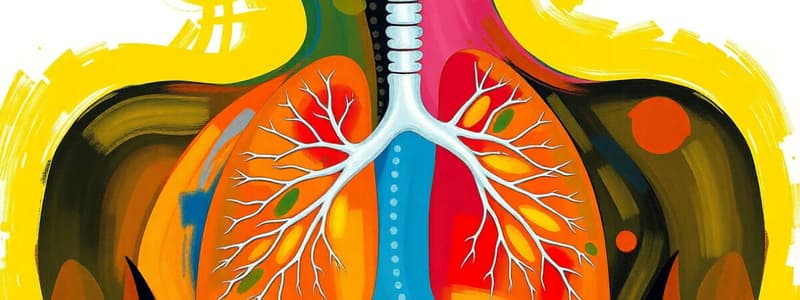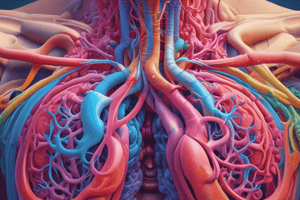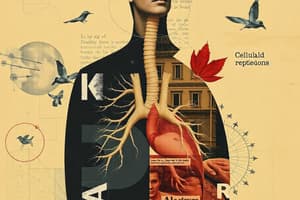Podcast
Questions and Answers
What is the primary energy carrier in cells that is produced during aerobic respiration?
What is the primary energy carrier in cells that is produced during aerobic respiration?
- Glucose
- Oxygen
- Carbon Dioxide
- ATP (correct)
Breathing is a voluntary process that requires conscious effort.
Breathing is a voluntary process that requires conscious effort.
False (B)
What are the two primary locations for gas exchange in the body?
What are the two primary locations for gas exchange in the body?
the lungs and body cells
The average person takes between __________ and __________ breaths daily.
The average person takes between __________ and __________ breaths daily.
Match the parts of the respiratory system with their functions:
Match the parts of the respiratory system with their functions:
What is the primary cause of Chronic Obstructive Pulmonary Disease (COPD)?
What is the primary cause of Chronic Obstructive Pulmonary Disease (COPD)?
Which of the following statements about alveoli is true?
Which of the following statements about alveoli is true?
Exhalation occurs when the diaphragm and chest muscles contract.
Exhalation occurs when the diaphragm and chest muscles contract.
The trachea is supported by complete rings of cartilage.
The trachea is supported by complete rings of cartilage.
What are the tiny air sacs in the lungs where gas exchange occurs called?
What are the tiny air sacs in the lungs where gas exchange occurs called?
What biochemical process converts glucose and oxygen into carbon dioxide, water, and energy?
What biochemical process converts glucose and oxygen into carbon dioxide, water, and energy?
The basic formula for aerobic cellular respiration is: sugar + oxygen → ______ + water + energy.
The basic formula for aerobic cellular respiration is: sugar + oxygen → ______ + water + energy.
Match the respiratory conditions with their characteristics:
Match the respiratory conditions with their characteristics:
Which structure connects the pharynx to the bronchi?
Which structure connects the pharynx to the bronchi?
Cilia are hair-like structures that help sweep mucus and trapped particles out of the airways.
Cilia are hair-like structures that help sweep mucus and trapped particles out of the airways.
What is the average number of breaths taken per day?
What is the average number of breaths taken per day?
The ______ is a large muscle beneath the lungs that plays a crucial role in breathing.
The ______ is a large muscle beneath the lungs that plays a crucial role in breathing.
Which of the following treatments can help manage asthma?
Which of the following treatments can help manage asthma?
Flashcards
Breathing
Breathing
The process of taking in oxygen and releasing carbon dioxide, essential for survival.
Alveoli
Alveoli
Tiny air sacs in the lungs where gas exchange happens.
Gas exchange
Gas exchange
The process of oxygen moving from the lungs into the blood and carbon dioxide moving from the blood into the lungs.
ATP (adenosine triphosphate)
ATP (adenosine triphosphate)
Signup and view all the flashcards
Aerobic respiration
Aerobic respiration
Signup and view all the flashcards
Ventilation
Ventilation
Signup and view all the flashcards
Respiratory pathway
Respiratory pathway
Signup and view all the flashcards
Respiratory membrane
Respiratory membrane
Signup and view all the flashcards
Diaphragm
Diaphragm
Signup and view all the flashcards
Asthma
Asthma
Signup and view all the flashcards
Chronic Obstructive Pulmonary Disease (COPD)
Chronic Obstructive Pulmonary Disease (COPD)
Signup and view all the flashcards
Puffer
Puffer
Signup and view all the flashcards
Inhalation
Inhalation
Signup and view all the flashcards
Exhalation
Exhalation
Signup and view all the flashcards
Study Notes
Respiratory System Overview
- Breathing is crucial for life, with an average person taking 17,000-29,000 breaths daily.
- A deep breath can encompass 3-4 liters of air, demonstrating lung capacity.
- Breathing is involuntary, managed by the autonomic nervous system.
Aerobic Cellular Respiration
- This biochemical process converts glucose and oxygen into carbon dioxide, water, and energy (ATP).
- The formula for aerobic respiration is: sugar + oxygen → carbon dioxide + water + energy
- ATP is the primary energy source for cellular functions.
Gas Exchange Process
- Gas exchange occurs in lungs and body cells.
- Alveoli, tiny air sacs in the lungs, are primary gas-exchange sites due to their extensive surface area and thin walls.
Air Pathway
- Air enters through nose/mouth, travels through the pharynx, epiglottis, and trachea.
- The trachea divides into bronchi, then bronchioles, ending in alveoli.
- The respiratory system filters, warms, and moistens air.
Respiratory System Structure
- The respiratory membrane's thinness and large surface area facilitate efficient gas diffusion.
- A rich blood supply transports gases to and from alveoli.
- Nasal hairs and mucus filter, moisten, and warm inhaled air; the oral cavity also intakes air, but provides less filtration.
Ventilation Mechanism
- Inhalation and exhalation involve the diaphragm and chest muscles.
- Inhalation: diaphragm contracts, chest expands, decreasing lung pressure, drawing air in.
- Exhalation: diaphragm and chest muscles relax, increasing lung pressure, forcing air out.
Breathing Control
- The nervous and circulatory systems regulate breathing, adjusting rate based on oxygen and carbon dioxide levels.
- High carbon dioxide levels prompt the brain to increase breathing rate and volume.
Respiratory Diseases
- Asthma: Chronic inflammation and narrowing of bronchi/bronchioles, causing airflow obstruction.
- COPD: Smoking-related, progressive lung disease (obstructive bronchitis and emphysema), damaging alveoli and lowering gas exchange.
Respiratory System Anatomy
- Alveoli: Tiny air sacs for gas exchange.
- Trachea: Windpipe connecting pharynx to bronchi, supported by cartilage.
- Diaphragm: Large muscle for inhalation/exhalation.
- Bronchi: Tubes branching from the trachea to the lungs.
- Cilia: Hair-like structures sweeping mucus from airways.
Respiratory Examination
- Breath sounds (auscultation) and respiratory rate are assessed to detect irregularities.
Key Facts
- Daily breaths: 17,000-29,000
- Deep breath volume: 3-4 liters
- Main energy molecule: ATP.
- Gas exchange locations: Lungs and body cells.
Key Terms/Concepts
- Aerobic Cellular Respiration: Oxygen-using process producing energy.
- Gas Exchange: Oxygen uptake and carbon dioxide removal.
- Ventilation: The process of breathing.
Studying That Suits You
Use AI to generate personalized quizzes and flashcards to suit your learning preferences.




